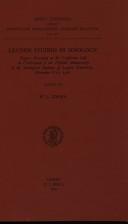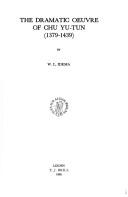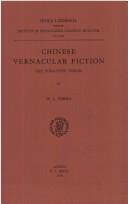| Listing 1 - 10 of 36 | << page >> |
Sort by
|
Book
ISBN: 0231536518 9780231536516 9780231165044 0231165048 Year: 2014 Publisher: New York, NY
Abstract | Keywords | Export | Availability | Bookmark
 Loading...
Loading...Choose an application
- Reference Manager
- EndNote
- RefWorks (Direct export to RefWorks)
The early Chinese text Master Zhuang (Zhuangzi) is well known for its relativistic philosophy and colorful anecdotes. In the work, Zhuang Zhou ca. 300 B.C.E.) dreams that he is a butterfly and wonders, upon awaking, if he in fact dreamed that he was a butterfly or if the butterfly is now dreaming that it is Zhuang Zhou. The text also recounts Master Zhuang's encounter with a skull, which praises the pleasures of death over the toil of living. This anecdote became popular with Chinese poets of the second and third century C.E. and found renewed significance with the founders of Quanzhen Daoism in the twelfth century.The Quanzhen masters transformed the skull into a skeleton and treated the object as a metonym for death and a symbol of the refusal of enlightenment. Later preachers made further revisions, adding Master Zhuang's resurrection of the skeleton, a series of accusations made by the skeleton against the philosopher, and the enlightenment of the magistrate who judges their case. The legend of the skeleton was widely popular throughout the Ming dynasty (1368-1644), and the fiction writer Lu Xun (1881-1936) reimagined it in the modern era. The first book in English to trace the development of the legend and its relationship to centuries of change in Chinese philosophy and culture, The Resurrected Skeleton translates and contextualizes the story's major adaptations and draws parallels with the Muslim legend of Jesus's encounter with a skull and the European tradition of the Dance of Death. Translated works include versions of the legend in the form of popular ballads and plays, together with Lu Xun's short story of the 1930s, underlining the continuity between traditional and modern Chinese culture.
Chinese literature --- Resurrection in literature. --- History and criticism. --- Zhuangzi --- Chuang Tzu --- Chwang Tszĕ --- Dschuang Dsi --- Tchouang-Tseu --- Tschuang-tse --- Tsjwang-Tze --- Tswang Tse --- In literature.

ISBN: 9789004488335 9789004065291 Year: 1981 Publisher: Leiden; Boston : BRILL
Abstract | Keywords | Export | Availability | Bookmark
 Loading...
Loading...Choose an application
- Reference Manager
- EndNote
- RefWorks (Direct export to RefWorks)

ISBN: 9789004482814 9789004072916 Year: 1985 Publisher: Leiden; Boston : BRILL
Abstract | Keywords | Export | Availability | Bookmark
 Loading...
Loading...Choose an application
- Reference Manager
- EndNote
- RefWorks (Direct export to RefWorks)
Drama --- Zhu, Youdun, --- Chu, Yu-tun, --- Criticism and interpretation. --- Criticism and interpretation.

ISBN: 9789004482807 9789004039742 Year: 1974 Publisher: Leiden; Boston : BRILL
Abstract | Keywords | Export | Availability | Bookmark
 Loading...
Loading...Choose an application
- Reference Manager
- EndNote
- RefWorks (Direct export to RefWorks)
Book
ISBN: 904500125X Year: 1999 Publisher: Amsterdam Atlas
Abstract | Keywords | Export | Availability | Bookmark
 Loading...
Loading...Choose an application
- Reference Manager
- EndNote
- RefWorks (Direct export to RefWorks)
Onder de opeenvolgende dynastieën van het Chinese keizerrijk was literatuur in de eerste plaats een mannenzaak. De literatuur van vrouwen was in vele opzichten marginaal: schrijvende vrouwen namen vaak een uitzonderlijke positie in en hun proza en poëzie vormen slechts een fractie van wat door mannen werd geproduceerd. Toch ontwikkelde zich in de loop van de tijd een eigen hoogwaardige traditie van vrouwenliteratuur. Deze traditie bestaat vooral uit lyrische poëzie, maar omvat ook traktaten, herinneringen en lange vertellingen. Dit boek biedt een representatieve en gevarieerde keuze uit het werk van schrijvende vrouwen uit het keizerlijke China. Hun teksten worden gepresenteerd tegen de achtergrond van eigentijdse biografische en autobiografische bronnen die een onverbloemd inzicht geven in de levensomstandigheden van vrouwen in de traditionele Chinese maatschappij.
Chinese literature --- anno 500-1499 --- anno 1500-1799 --- anno 1-499 --- anno 1800-1999 --- S16/0195 --- S05/0200 --- S11/0720 --- China: Literature and theatrical art--Thematic studies --- China: Biographies and memoirs--General and collective --- China: Social sciences--Women's emancipation movement: general and before 1949 --- Women authors, Chinese --- Women authors. --- China --- Chinese women authors --- Women authors --- History --- Writers --- Women's literature --- Book
Book
ISBN: 0231538103 9780231538107 9780231168540 0231168543 Year: 2014 Publisher: New York, NY
Abstract | Keywords | Export | Availability | Bookmark
 Loading...
Loading...Choose an application
- Reference Manager
- EndNote
- RefWorks (Direct export to RefWorks)
This is the first anthology of Yuan-dynasty zaju (miscellaneous comedies) to introduce the genre to English-speaking readers exclusively through translations of the plays' fourteenth-century editions. Almost all previous translations of Yuan-dynasty zaju are based on late-Ming regularized editions that were heavily adapted for performance at the Ming imperial court and then extensively revised in the seventeenth century for the reading pleasure of Jiangnan literati. These early editions are based on leading actor scripts and contain arias, prose dialogue, and cue lines. They encompass a fascinating range of subject matter, from high political intrigue to commoner life and religious conversion. Crackling with raw emotion, violent imagery, and colorful language and wit, the zaju in this volume explore the consequences of loyalty and betrayal, ambition and enlightenment, and piety and drunkenness. The collection features seven of the twenty-six available untranslated zaju published in the fourteenth century, with a substantial introduction preceding each play and extensive annotations throughout. The editors also include translations of the Ming versions of four of the included plays and an essay that synthesizes recent Chinese and Japanese scholarship on the subject.
Book
ISBN: 1501758373 9781501758386 1501758365 1501758381 9781501758379 9781501758362 Year: 2021 Publisher: Ithaca, NY
Abstract | Keywords | Export | Availability | Bookmark
 Loading...
Loading...Choose an application
- Reference Manager
- EndNote
- RefWorks (Direct export to RefWorks)
'The Pitfalls of Piety for Married Women' shows how problematic the practice of Buddhist piety could be in late imperial China. Two thematically related 'precious scrolls' (baojuan) from the Ming dynasty, The Precious Scroll of the Red Gauze and The Precious Scroll of the Handkerchief, illustrate the difficulties faced by women whose religious devotion conflicted with the demands of marriage and motherhood. These two previously untranslated texts tell the stories of married women whose piety causes them to be separated from their husbands and children.
Bao juan (Buddhist song-tales) --- Chinese drama --- Wives --- Buddhist women --- Women, Buddhist --- Women --- Spouses --- Housewives --- Married women --- Pao chüan (Buddhist song-tales) --- Folk drama, Chinese --- Religious life --- Buddhist piety, Female religiosity, Ming dynasty vernacular literature, Precious Scrolls,.
Book
Abstract | Keywords | Export | Availability | Bookmark
 Loading...
Loading...Choose an application
- Reference Manager
- EndNote
- RefWorks (Direct export to RefWorks)
Acting --- Theatrical science --- Drama --- theater
Book
ISBN: 9789025316198 Year: 2023 Publisher: Amsterdam Athenaeum-Polak & Van Gennep
Abstract | Keywords | Export | Availability | Bookmark
 Loading...
Loading...Choose an application
- Reference Manager
- EndNote
- RefWorks (Direct export to RefWorks)
Book
Abstract | Keywords | Export | Availability | Bookmark
 Loading...
Loading...Choose an application
- Reference Manager
- EndNote
- RefWorks (Direct export to RefWorks)
| Listing 1 - 10 of 36 | << page >> |
Sort by
|

 Search
Search Feedback
Feedback About UniCat
About UniCat  Help
Help News
News